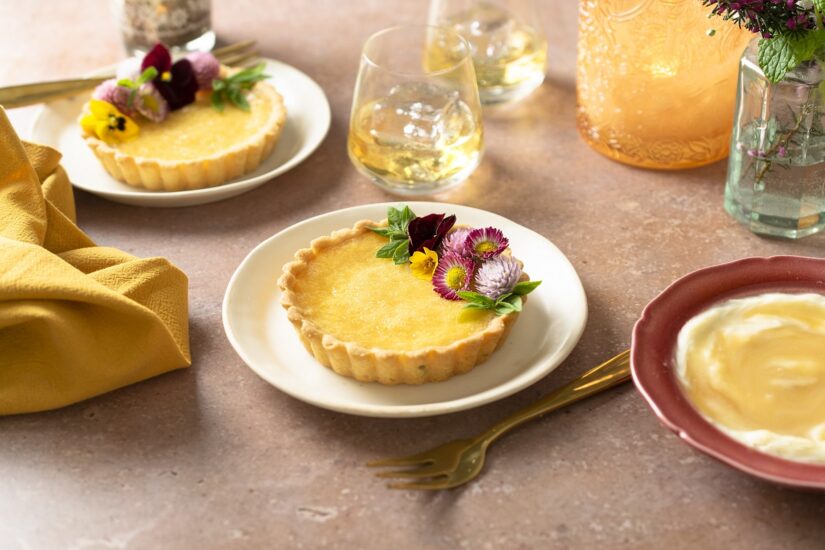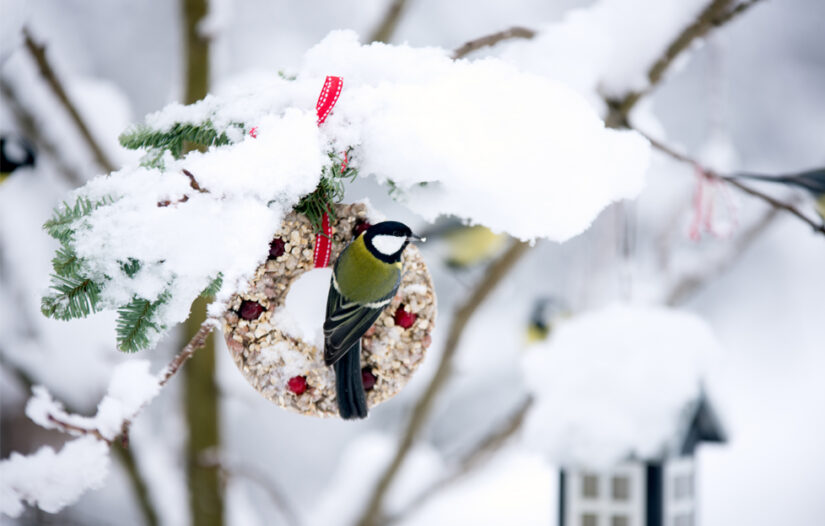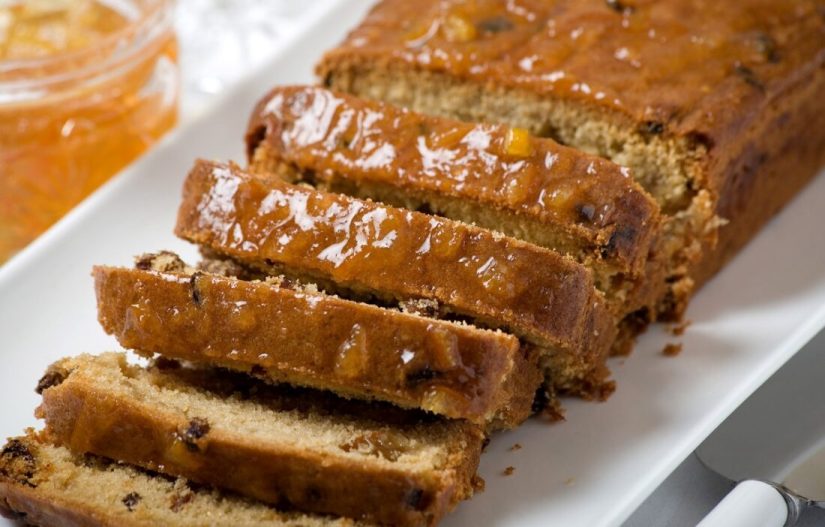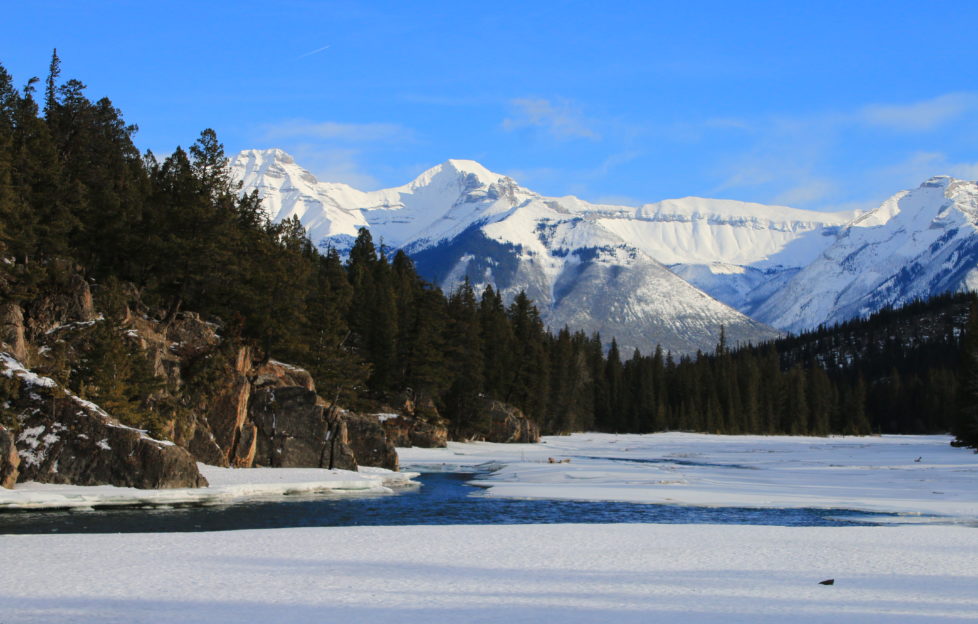
Today is Canada Day, a national holiday celebrating the birth of that modern nation.
“The People’s Friend” has quite a few readers out in Great White North. So we’ve decided to mark the occasion by sharing this article from January last year.
In it, Pat Coulter slipped on her snow shoes to explore the majestic Canadian Rockies.
A winter holiday usually means chasing some sunshine, ideally on a far-flung beach. This time it’s warm woollies at the ready, as I’m off on a winter wonderland adventure for a full-on, magical snow experience to the awe-inspiring Canadian Rockies.
After a nine-hour flight from London’s Heathrow, we touch down at Calgary airport. Although understandably eager, we try not to stampede our way on to the tour bus!
I’ve joined an escorted group of 30 or so intrepid travellers, from twenty-somethings to those in their seventh decade. All of us are cheerfully up for adventurous sightseeing in Canada’s most iconic National Parks: Banff and Jasper.
Patrick, our knowledgeable tour guide, is a Canadian Rockies native, and he is enthusiastically sharing his passion for this beautiful landscape.
The city soon gives way to rugged, snow-covered peaks and frozen lakes. It’s like stepping into Narnia, except this is for real, and Mr Tumnus is replaced by foraging elk seen from our tour bus.
The sight of a huge ski jump is a reminder that the winter Olympics were held here back in 1988. Respect to Eddie “The Eagle” Edwards, who flew from the terrifyingly vertiginous ramp.
Embrace the wintry conditions
The grizzlies might be hibernating in their snow-covered dens, but unlike those snoozing bears, I soon discover the sports-minded, outdoorsy Canadians embrace the wintry conditions with huge enthusiasm.
Yes, it’s a finger-numbing minus twenty, but they are undeterred. There are plenty of skaters and ice-hockey players getting actively warm on the outdoor ice rink just beyond my bedroom window in downtown Banff. Extraordinarily, I even spot a young mother skating along, pushing her toddler in a buggy with a dog in tow. How’s that for multi-tasking?
Thermals on, I venture into the charming Christmas-card scene, enjoying the satisfying crunch of my boots on the crisp snow. The government names the thoroughfares in Banff after native wildlife. There’s a Bear, a Wolf and a Muskrat Street. Even my hotel is called Elk.
Banff is a friendly kind of town, where everyone knows each other and visitors receive a warm welcome in cosy, log-fired restaurants and bustling bars. I feel like an honorary Canadian when settling down to enjoy a mighty tasty elk burger (think venison on a super-sized scale), accompanied by crisp green salad, topped off with crunchy, maple-syrup infused pecan nuts.
I’ve even taken to watching televised ice-hockey matches. Well, it is a national obsession.
Squeezing into our swimming costumes
Next day, the festive feel continues with a horse-drawn sleigh ride – complete with real bells a-jingling as a pair of sturdy horses effortlessly glide us through the snow-covered forest. Thankfully, we snuggle under lap-warming blankets!
A coyote lopes past, reminding us this is a genuine wilderness, and we are merely its privileged guests. Hot chocolate beckons, and we toast marshmallows over a crackling open fire.
Just as we’re thawing out, Patrick reminds us that it’s time for our outdoor bath. Yes, folks, unbelievably we’re stripping off our thermals and squeezing into our swimming costumes.
Fortunately, our alfresco ablutions are in Banff’s natural hot springs. The water is positively steaming. It’s the perfect place to lie back, relax and enjoy one of the most unspoiled, natural landscapes on earth.
Looking out across frozen Bow River, we are surrounded by magnificent mountains where grizzly bears slumber and wolves roam.
Impressively housed in a log fortress on the bank of the frozen Bow, Banff’s Buffalo Nations Luxton Museum gives a fascinating insight into the First Nations indigenous people of Canada.
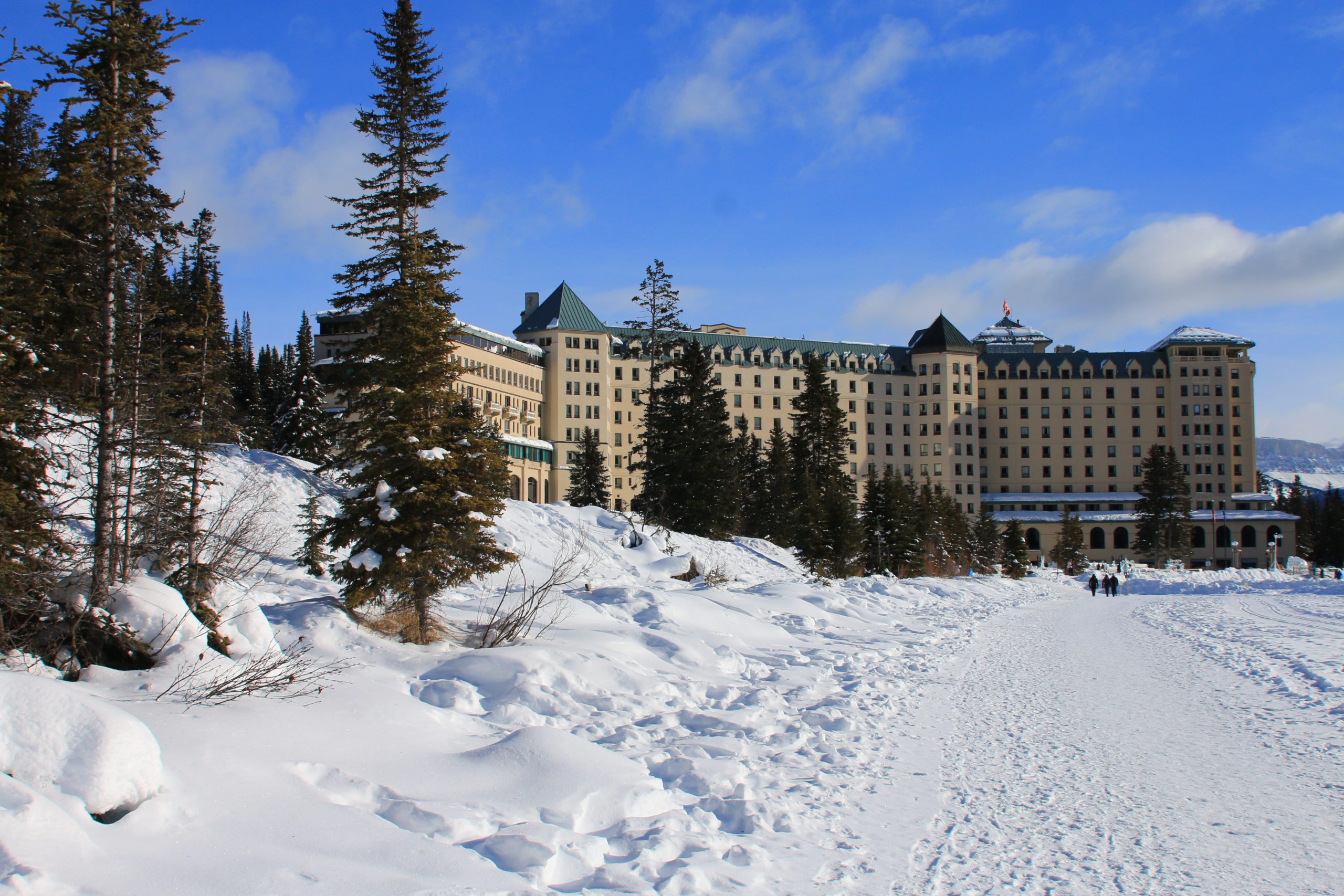
Photograph by Pat Coulter.
One of the world’s most iconic road trips
“The First Nations knew the land before anyone else,” museum director Gloria Cowley says.
The story of the original people of the mountains, the Stoney Nakoda, comes to life on the heritage museum’s journey back in time.
When the first European pioneers arrived, they discovered a culture rich in elaborate ceremonies, dances, songs and legends associated with the spirit world and nature’s cycle. It’s a marvel to appreciate up close their original handicraft: intricate, colourful beadwork necklaces interwoven with porcupine quills, elaborate eagle-feathered headdresses and hand-stitched hide moccasins.
It’s impressive how resourceful and resilient the First Nations people really were, and how they cherished this sacred land of their forebears.
Our pioneering tour group continues west into the Rockies, on one of the world’s most iconic road trips – along the Icefields Parkway towards Jasper.
This is treacherous avalanche country. Even though we are following a snowplough, the road remains a blanket of white. The mountains turn moody, and the scene is like looking at a black and white photograph.
They breed them tough in Canada!
We see only a few local pick-ups along the highway; a contrast to the tourist hordes who come here in the summer.
We stop to admire ice-climbers ascending a perilous-looking frozen waterfall, chipping away with their razor-sharp ice picks.
Along the way, we see backcountry skiers enjoying the champagne powder snow off-piste. An adventurous spirit is in their DNA. There’s no doubt they breed them tough in Canada!
It feels like we’re in the Arctic as we step from the warm comfort of our bus into the wind-whipped, white-out landscape. Snow pelts our faces as we stand on the mighty Columbia Icefield, with the jaw-droppingly beautiful Athabasca Glacier looming in the background.
There’s not another vehicle in sight, but in the summer visitors can take giant snow coaches on to the icefield. But none of that today; the visitor centre is closed until the spring.
An igloo would be more appropriate
It’s just us and the icy elements in an inhospitable environment. We’re thrilled to be a part of it, of course. Although we’re thankful we are not camping here tonight! An igloo would be more appropriate.
After our day-long drive, Jasper really does feel like the outpost it genuinely is. Journey on the famous Rocky Mountaineer train and you’ll come this way. We wait 10 minutes at the crossing as a mile-long train laden with lumber rumbles into the station.
The highlight of any stay in Jasper is the Maligne Canyon Ice Walk, and we’re about to discover why it’s the area’s most popular winter attraction. Ice cleats attached to our boots ensure our surefootedness. As snow gently falls, our guide leads us down into the precipitous rocky ravine.
He encourages us to pick and nibble at berries – a favourite snack for grizzly bears. We even munch on fragrant pine needles. We’re sure to have some fresh breath!
In summer, kayakers negotiate the raging river flowing through Maligne Canyon. For us, it’s transformed into a magical winter wonderland. The frozen river is our walkway, with the sheer canyon rock face above adorned with sparkling frozen waterfalls and ice-cavern grottos.
The environment feels other-worldly; it’s such a unique experience.
A warming drink back at our lodge-style hotel in front of a blazing fire, followed by a delicious Canadian signature dish of cedar plank salmon, ends a memorable day in Jasper National Park.
The Canadian Rockies in Alberta has welcomed tourists ever since the Canadian Pacific Railway opened accessibility to the masses over a century ago. With it came iconic hotels like the Fairmont Chateau Lake Louise.
We’re up for another adventure
The hotel takes its name from the most famous glacial lake in the Canadian Rockies – and one of the most beautiful in the western hemisphere.
The lake, and indeed the province of Alberta, is named in honour of Princess Louise Caroline Alberta, fourth daughter of Queen Victoria and Prince Albert. The princess spent many years living in Canada after her husband was made Governor General.
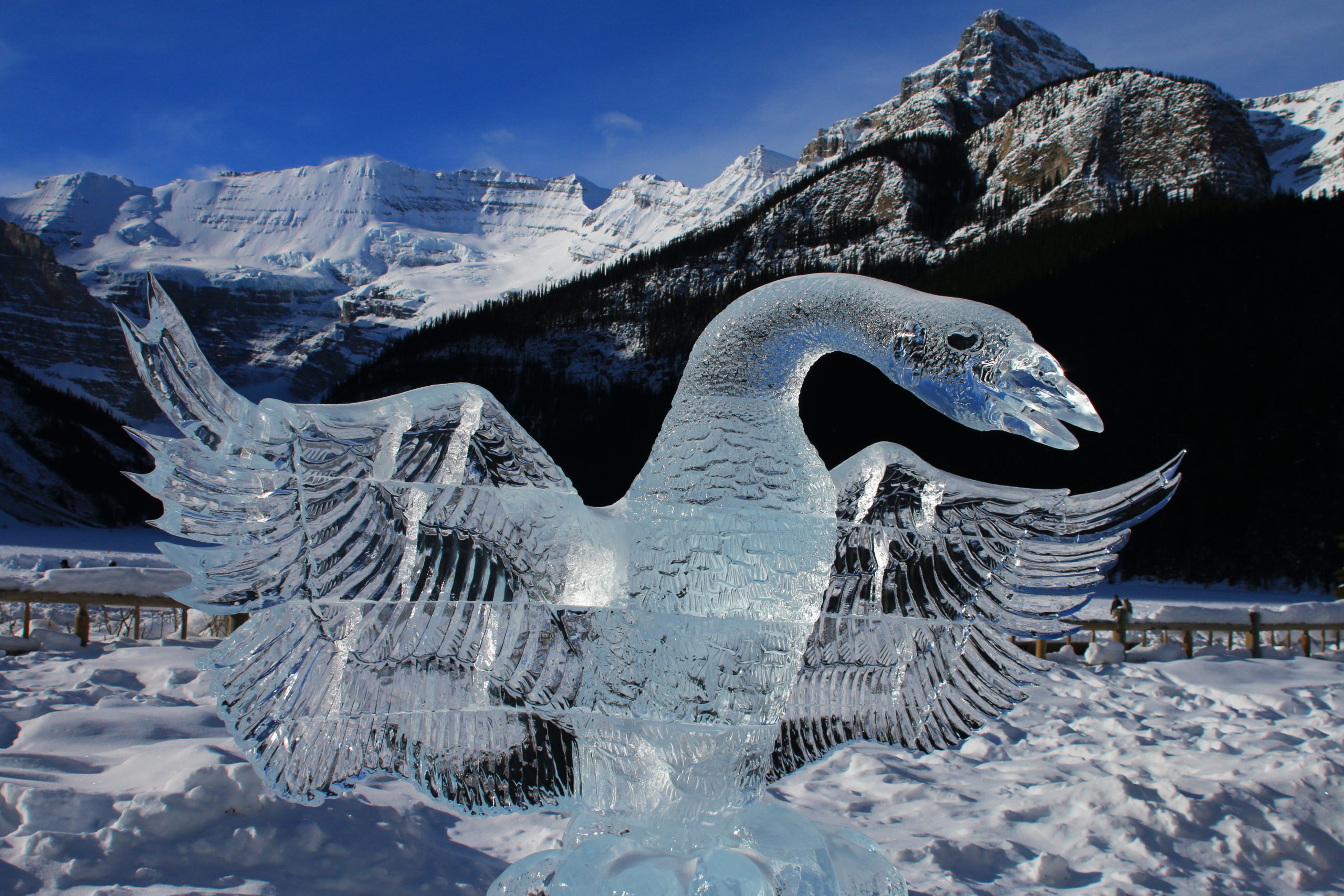
Photograph by Pat Coulter.
We’re thrilled our stay coincides with the annual Ice Magic Festival.
The festival attracts ice sculptors from around the globe to showcase their art, chiselled from giant blocks of ice and preserved by the constant sub-zero temperatures.
Despite their skill, the greatest ice formation at Lake Louise is the Victoria Glacier at the head of the lake. We can get a closer view by literally walking on water – frozen water – for a hike across the mile-long lake.
Later, we’re up for another new adventure, donning shoe shoes for a fun hike in the powder-soft snow. Without the shoes we’d be up to our waists!
It gives us a wonderful sense of freedom, walking so effortlessly in challenging terrain. We had better tread carefully, though. I don’t fancy waking those slumbering bears!
Travel restrictions may still be in place. Please check latest advice before planning your trip.
For more on Canada Day, click here.
For more fantastic “Friend” features, click here.

